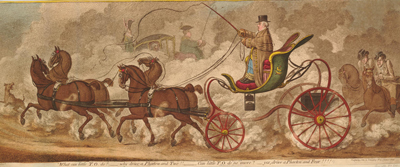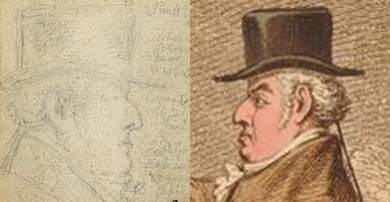What Can Little T.O. Do?
This large (10 x 26 inches), beautifully finished, and only slightly caricatured print features the Honourable Thomas (Tommy) Onslow (1754-1827), dressed in coachman's garb, driving a high-flyer phaeton carriage pulled by four horses—"a Phaeton and Four."

© Trustees of the British Museum
Appropriately named for the son of Helios who attempted (with disastrous results) to drive the chariot of his father the Sun God, a "Phaeton" was an "open" carriage i.e. without doors. It was generally lighter and faster than other coaches but also more dangerous. The high-flyer version set on light springs (shown in Gillray's print) was especially so because of its high center of gravity. Gillray's comment on that sort of vehicle may be the small crest on the side of the phaeton showing a man on horseback with a fool's cap on.
Driving a phaeton or other horse-drawn carriages required skill and judgment, the moreso as the number of horses to be managed increased. ("Can little T.O. do no more? yes, drive a Phaeton and Four!!!!") As a result, most carriage owners, like the one passing by in the background of Gillray's print, were content to leave the driving to their expert coachmen. But for the young bucks about town, learning to drive a coach and four on a par with a professional driver was both a challenge and an accomplishment to be bragged about. According to John Timbs in his chapter on the Four-in-Hand Club in Club Life of London, the
closeness with which the professional coachmen were imitated by the "bucks," is shown in the case of wealthy young Ackers, who had one of his front teeth taken out, in order that he might acquire the true coachman-like way of "spitting."
A Whig member of Parliament and friend of the Prince of Wales, Tommy Onslow probably developed his interest in fast carriages while he was part of the fast crowd surrounding the Prince of Wales in the 1780s. Later, he may have been a model for the horse and carriage-loving Goldfinch, a character in Thomas Holcroft's 1792 play, The Road to Ruin.
He seems to have delighted in shocking people with his skill and daring. Thomas Wright quotes from a contemporary account describing Onslow as
so skillful a whip that he might be daily seen, in the high spring-tide of fashion picking his way, four-in-hand, in and out amidst the crowded cavalcade of Bond-Street, driving to a hair's breadth.
And John Timbs, quoting from another contemporary in the Athenaeum, notes that
Tommy Onslow was a little man, full of life and oddities, one of which was a fondness for driving into odd places; and I remember the surprise of a pic-nic party, which he joined in a secluded spot, driving up in his 'phaeton and four' through ways that were hardly supposed passable by anything beyond a flock of sheep.
Gillray may be portraying just such an example of calm audacity in What Can Little T.O. Do? Both the guard dog and the footman of the other carriage are showing alarm at how close Onslow is coming to them. But Onslow and the professional coachman remain (of course) unperturbed.
Gillray typically created prints that would take advantage of the popularity or notoriety of his subject. And the investment in the print was ordinarily calculated based on the expected return. In the case of What Can Little T.O. Do?, the investment must have been considerable: the print is almost twice as wide as most of Gillray's prints and there is an exquisite attention to detail. In the portrayal of the horses, the coach with its felt seat and foot rest (specially designed for a "little person"), the coachman's overcoat and capes, the disgruntled young bucks on horseback annoyed by the billows of dust kicked up by Onslow's phaeton—this was clearly a print upon which no effort was spared.
But the only notice of Tommy Onslow in the year 1801 does not occur until June, a month after the date of this print, when his father, George Onslow, was made an Earl and he became Lord Cranley. That announcement appeared in multiple newspapers, including the London Star, London Porcupine and Morning Post Gazetteer. But even then it was not the sort of event like the secret marriage of the Prince of Wales that would have generated a lot of business outside the circle of Onslow and his friends. My guess, therefore, is that the print was likely commissioned by Onslow or his family for the occasion of his elevation to the title, Lord Cranley. But what it celebrated was not his elevation to a new rank but his longtime passion for driving a phaeton and four.
The title is based on an epigram quoted in Timbs that was supposedly current even before Gillray's print appeared.
What can Tommy Onslow do?
He can drive a coach and two!
Can Tommy Onslow do no more?
He can drive a coach and four."
The exact wording varies according to the carriage driven.
Gillray's publication line indicates that it was done "to the life," ad vivm. For Gillray that usually means that it is based on a sketch that he drew of the subject's head. And in this case, there is a drawing in the British Museum (currently listed as BM#1851,0901.139, "Head of a man in profile to right. . .") that is almost certainly the sketch he used.

© Trustees of the British Museum
Sources and Reading
- Commentary from the British Museum on What Can Little T.O. Do?.
- "Thomas Onslow, 2nd Earl of Onslow," Wikipedia
- "Driving club," Wikipedia
- "Phaeton (carriage)," Wikipedia
- "Coach (carriage)," Wikipedia
- John Timbs, "The Four-in-Hand Club" in Club Life of London
- Thomas Wright and R.H. Evans, Historical and Descriptive Account of the Caricatures of James Gillray #502.
- Thomas Wright and Joseph Grego, The Works of James Gillray, the Caricaturist; With the History of His Life and Times, p. 283.
Comments & Corrections
NOTE: Comments and/or corrections are always appreciated. To make that easier, I have included a form below that you can use. I promise never to share any of the info provided without your express permission.